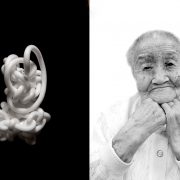Brian Eno once quipped that artists are either farmers or cowboys. One settles down with their tools to develop their plot of artistic terrain, while the other always wonders what’s over the next horizon, in restless pursuit of a new subject, a novel material or innovative technique.
While I fall neatly in to the farmer category, the Korean artist Sangsun Bae is the definitive cowboy. Following her years of training as an oil painter, Sangsun chose to study print making for a term at the Royal College of Art, before upping camp and moving on to create a series of dynamic knot drawings in charcoal on white canvas. These were soon followed by delicately tangled lines of white gesso on rich, black velvet, then a whole collection of ceramic knots crafted during a residency in Jingdezhen, China’s porcelain capital.
I should also add the disclaimer that Sangsun Bae is my wife, and so I’ve followed her recent project ‘Moonbow’ from conception to it’s latest manifestation at KG+ Select, an open-entry art exhibition held as part of ‘Kyotography’, Kyoto’s annual international photography festival.
Moonbow arose from a 4 year socio-historical research project in to the lives of Japanese citizens raised in Daejeon, South Korea. Daejeon’s origins are as a colonial city, built by the Japanese as a relay point along the Gyeongbu railway line, completed in 1905 to move military supplies from Busan to Seoul during the Russo-Japanese war.
Following the annexation of Korea in 1910, the number of Japanese residents rose from 600 to 2500, as Japanese migrants moved to the region in search of work, building Japanese styles houses and raising families adjacent to a Korean population of 1700.
In 1945 at the end of the second world war, Daejeon’s Japanese residents were forced to cut ties and return to Japan, leaving behind their properties and livelihoods. Many struggled to readjust to life in their homeland, where they faced discrimination for having spent so much time abroad. Sangsun gained access to a community of Japanese, now in their 80’s and 90’s, who spent their childhoods in Daejon. Using material from their conversations and photo albums, Sangsun set about to present their untold story through Moonbow.
On opening the sliding glass door to enter the exhibition we move a thin, translucent image of a shy young girl behind that of an elderly woman, only to realise they’re the same person separated by over 70 decades. The windows of the space are also covered in faded transparencies of unsmiling Japanese soldiers stood in awkward formations in anonymous locations, their names and ranks edited out.
Surrounding these are coloured pictures of stamps on letters posted to Japan from South Korea, and leaves from bushes planted by the Japanese in Daejeon, still growing there today. From a cupboard in the corner of the room comes the faint sound of blood in rhythmic pulses. Opening the cupboard doors reveals an animated mass of entangled silk threads, which look more like an insect trying to break out of it’s cocoon than a throbbing heart. These suspended bundles of multicoloured silk threads appear elsewhere in large, high resolution photographs titled Chandeliers.
In English we speak of the ‘tapestry’ of history and a ‘fabric’ of society made of ‘bonds’ between people and place, showing the metaphors of weaving, threads and knots to be of primal cultural importance. Throughout her career Sangsun has continually adapted these motifs to portray subtle emotional states, and the abstract relationships that exist between individuals and communities. The strongest works in the show are a circle of paired photographs that contrast portraits of elderly men and women with various images of knotted porcelain and black entwined coils.
In Moonbow Sangsun draws on her wealth of experience in materials and techniques to deal with the difficult subject of identity at the level of the individual, family and nation. She avoids an overtly political approach to portray her subjects instead as civilians caught up in a series of turbulent, somewhat tragic events. Now, toward the end of their lives, they’ve become a community in search of lost time, nostalgic for the idyllic Daejeon of their youth, and detached from troubling historical records of 35 years of colonial and imperial Japanese rule.
What’s of most interest however, is how the Moonbow project was received in modern day Japan. Having been covered by several newspapers, Japanese academics and guest speakers from Daejeon city museum spoke to over 100 guests in a packed lecture theatre at Ritsumeikam University Museum for Peace Studies. At one artists talk event extra seating was rushed in to cope with the unexpected number of visitors, several of whom took the opportunity to share their own highly emotive stories of secretive familial ties to Korea in public for the first time.
Current political tensions between South Korea and Japan center on contradictory historical narratives and minor territorial claims. Sangsun Bae’s Moonbow project was initiated by funding from the Daejeon Culture Foundation in South Korea, then further supported by the Han Chang Woo ‘Tetsu Cultural Foundation’ in Japan, before being selected for exhibition as part of Kyotography’s KG+.
Despite being a skeptic of the fashionable term ‘Socially engaged art’, to my mind the success of Moonbow and the support it received from both South Korea and Japan sets a great precedent for tentative steps towards an international reconciliation though art.
